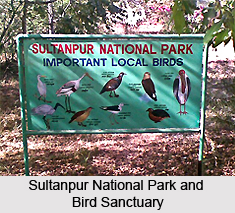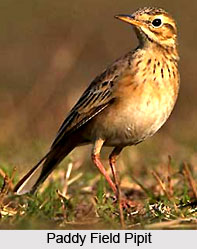 Sultanpur National Park and Bird Sanctuary is considered to be one of the most popular and well known bird sanctuaries in India. The sanctuary is located in the Gurgaon district, in the state of Haryana and it is an ideal place for birding and bird watchers. It is home to numerous species of birds, animals and mammals. The sanctuary is best visited during the winters, as a large number of migratory birds visit during that period. The place also witnessed a number of organisms like crustaceans, fish and insects thriving during floods, and as a result, several birds get attracted to this area.
Sultanpur National Park and Bird Sanctuary is considered to be one of the most popular and well known bird sanctuaries in India. The sanctuary is located in the Gurgaon district, in the state of Haryana and it is an ideal place for birding and bird watchers. It is home to numerous species of birds, animals and mammals. The sanctuary is best visited during the winters, as a large number of migratory birds visit during that period. The place also witnessed a number of organisms like crustaceans, fish and insects thriving during floods, and as a result, several birds get attracted to this area.
History of Sultanpur National Park and Bird Sanctuary
For over one hundred years now, Sultanpur Jheel has been attracting birds. But it was only in 1969, at the Conference of the International Union of Conservation of nature and Natural resources (IUCN) in New Delhi, that the potential of this wetland was highlighted in official quarters. The potential of the Sultanpur National Park and Bird Sanctuary to become a bird preserve was first identified by an enthusiastic bird watcher, Mr. Peter Jackson. He then convinced the then Prime Minister of India, Ms. Indira Gandhi, about the need for giving protection to this area and became successful in convincing. As a result the Government of India declared the area covering 359 acres as a Bird Sanctuary in the year 1971 and it was again upgraded to the status of National Park in 1991 by the State Government of Haryana. The Jheel (an area of 1.21 sq. Km.) was accorded Sanctuary status under section 8 of the Punjab Wildlife Preservation Act of 1959. The status of the park was upgraded to National Park under Section 35 of the Wildlife (Protection) Act, 1972 on July 5th, 1991. Simultaneously the area was increased to 1.42 sq. Km. The National Park has been carved out of the land of Sadhrana, Chandu, Sultanpur and Saidpur villages.
Climate of Sultanpur National Park and Bird Sanctuary
The climate of this place is tropical with hot summers and chilly winters and it has its monsoon rains in the month of July till mid September. The most favourable time to visit this sanctuary is considered to be during the period of October to March. Sultanpur has the typical North Indian climate of harsh summers up to 46 degree C and cold winters which is as low as 9 degree C. Rainy season is short, from July to the end of August.
Flora of Sultanpur National Park and Bird Sanctuary
The vegetation of Sultanpur National Park and Bird Sanctuary is tropical and dry deciduous and the flora include grasses, dhok, khair , tendu, ber, jamun, banyan tree, neem, berberis, Acacia nilotica and Acacia tortilis. The vegetation of the Sultanpur National Park and Bird Sanctuary mainly comprises of tropical and dry deciduous forests. Thus, the trees like babul, savannah grasses, acacia, jamun and banyans are dotting its landscape. As the soil of the sanctuary is also quite fertile, it can be found carpeted with lawns, trees, shrubs and heaps of bougainvilleas, as well.
Fauna of Sultanpur National Park and Bird Sanctuary
The Sultanpur National Park and Bird Sanctuary is home to about 250, out of a total 450 species of birds, found in Haryana. Some of the birds are residents of this sanctuary, while the others come from distant regions like Siberia, Europe and Afghanistan.
Resident Birds: The resident birds of the sanctuary include the Common Hoopoe, Paddy Field Pipit, Purple Sunbird, Little Cormorant, Eurasian Thick-knee, Gray Francolin, Black Francolin, Indian Roller, White-throated Kingfisher, Spot billed Duck, Painted Stork, White Ibis, Black headed Ibis, Little Egret, Great Egret, Cattle Egret, India Crested Lark, Red vented Bulbul, Rose ringed Parakeet, Red wattled Lapwing, Shikra, Eurasian collared Dove, Red collared Dove, Laughing Dove, Spotted Owlet, Rock Pigeon, Magpie Robin, Greater Coucal, Weaver Bird, Bank Mynah, Common Mynah and the Green Bee Eater.

Migratory Birds: Apart from the resident birds, the Sultanpur National Park and Bird Sanctuary also witnesses more than a 100 migratory bird species, every year. These birds come to the sanctuary in search of feeding grounds and to pass the winter. Some of the most notable migratory bird species found in the sanctuary include the Siberian Cranes, Greater Flamingo, Ruff, Black winged Stilt, Common Teal, Common Greenshank, Northern Pintail, Yellow Wagtail, White Wagtail, Northern Shoveler, Rosy Pelican, Gadwall, Wood Sandpiper, Spotted Sandpiper, Eurasian Wigeon, Black tailed Godwit, Spotted Redshank, Starling, Blue throat and the Long billed Pipit. All these bird species visit the sanctuary during winter. Apart from them, about 11 species of migratory birds visit the Sultanpur National Park and Bird Sanctuary during summer. These birds include the Asian Koel, Black crowned Night Heron, Eurasian Golden Oriole, Comb duck, Blue cheeked Bee Eater, Blue-tailed Bee-Eater and the Cuckoos.
Apart from the vegetation and birds, the sanctuary is also home to a number of common animals. Some of the most commonly seen animals in this sanctuary include the Striped Hyena, Leopard, Nilgai, Sambar, Blackbuck, Hog Deer, Four Horned Antelope, Caracal, Wild Dog, Rattle/Honey Badger, Mongoose, Hedgehog, Wild Pig, Wild Cat, Indian Porcupine, etc.
Tourism in Sultanpur National Park and Bird Sanctuary
During the ideal period of September to March, the ornithologists and the bird-lovers can make a sure shot visit in this area where safari is not available but the tourist can enjoy nature`s walk in area during the day time. Although the park is open throughout the area for the people to enjoy picnic and lucrative moments here. The bird sanctuary in Sultanpur is the most lush green area to attract around 250-300 species of avi-faunas and more than that during winters to make the area more lively and pleasant. Although the tourists prefer winters to visit this sanctuary so as to find the maximum counts of migratory species in the area.
Visiting information
Sultanpur National Park and Bird Sanctuary is easily accessible by both air and road. The sanctuary is approximately 35 km away from Indira Gandhi International Airport, New Delhi. A taxi or bus can be taken from the airport. Gurgaon Railway Station is the nearest railway station connected to Delhi which is 15 km away. Also Gurgaon Bus Stand, Dhaula Kuan Bus Stop are nearest for the tourists willing to visit by bus. From Gurgaon there are regular buses to the Sultanpur National Park run by Haryana State Roadways. Gurgaon is connected to Delhi by buses. Taxis and tourist cars are also available on hire from Delhi and Gurgaon to visit Sultanpur.
The park is also named as Dr. Salim Ali Bird Sanctuary after the famous Indian ornithologist and naturalist to pay tribute to his miscellaneous efforts in natural conservation.











